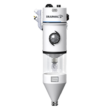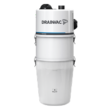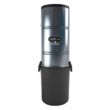A central vacuum is a powerful unit that leaves no chance to dust. It is important to know that it relies on a piping network to operate, and objects or detritus accumulation may occur.
A clogged piping network can greatly reduce the vacuum’s performance and even prevent it from working. However, do not be afraid of clogged pipes since it is possible to unclog them yourself! Here are some tips on how to deal with this problem.
The first thing you should do if you notice a significant power loss is to inspect your unit by removing the pipe from the air inlet and starting the vacuum manually using the power switch.
Then, check if there is any suction by covering the opening with your hand. If you don’t feel anything, your unit is defective. In this case, you will need to contact your nearest retailer to find the source of the problem.
If the source of the problem is with the unit, the second thing to do is to test the vacuum hose to see if a clog has formed in it. Simply insert a small object like a coin through one end. If it comes out of the other opening of the hose when you pass it through, it means that it is not clogged.
Inspect the Piping Connected to Your Central Vacuum
Once you have inspected the hose, you need to make sure that the piping is in good condition. The older it is, the more vulnerable it becomes. Hard objects like coins can pierce through if there’s a strong impact. Pipes may also be dislodged from one another if they are not glued together and may create small openings which results in power loss.
To inspect the piping network, you must test the suction power of each vacuum outlet by starting with closest one from the unit. As you move further away from the unit, you should find where the air is lost.
If the piping is in good condition, the power loss is probably caused by a clog. Try turning on your vacuum using the switch on the unit and check your outlets. When one of them does not suck, it means that the clog is located near it. To solve the problem, you will need to use an auxiliary vacuum cleaner. Simply insert the hose of this device into one of your wall outlets and vacuum for about 30 seconds.
The solutions listed above are generally effective if you are experiencing suction problems with your central vacuum. However, if you continue to have difficulties after following these steps or if you have any doubts, do not hesitate to contact your nearest retailer or to contact us directly!














